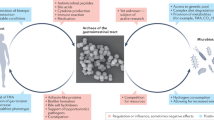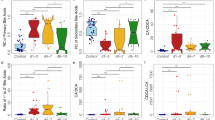Summary:
Methane-forming microbes of the phylogenetic domain Archaea are part of the strictly anaerobic microflora of the human intestine. In bone marrow transplant (BMT) recipients, the regimen of intestinal decontamination with metronidazole is targeted to anaerobic bacteria. The effect on the anaerobic methanoarchaea, however, is unknown. Therefore, the faeces of patients undergoing BMT were investigated for methane production. The anoxic Hungate technique and an archaeal growth medium were used to culture faecal specimens. Methane production was measured in the head space of the culture bottles by gas chromatography using a thermal conductivity detector. In a testing serial specimen of 100 patients, 13 patients were found to bear methanogens, and 11 of these patients received metronidazole. The methane-producing faecal specimens occurred before metronidazole use in three patients, during the first week in five patients, and after cessation in three patients. No specimen of the 11 patients that was obtained during the 2nd–5th week of gut decontamination showed methane production. It is concluded that use of metronidazole directed against faecal anaerobic bacteria also suppresses or eliminates faecal methanogenic Archaea.
This is a preview of subscription content, access via your institution
Access options
Subscribe to this journal
Receive 12 print issues and online access
$259.00 per year
only $21.58 per issue
Buy this article
- Purchase on Springer Link
- Instant access to full article PDF
Prices may be subject to local taxes which are calculated during checkout
Similar content being viewed by others
References
Woese CR, Kandler O, Wheelis ML . Towards a natural system of organisms: proposal for the domains Archaea, Bacteria, and Eucarya. Proc Natl Acad Sci USA 1990; 87: 4576–4579.
Garcia JL . Taxonomy and ecology of methanogens. FEMS Microbiol Rev 1990; 87: 297–308.
Miller TL, Wolin MJ . Methanogens in human and animal intestinal tracts. System Appl Microbiol 1986; 7: 223–229.
Dermoumi HL, Ansorg RAM . Isolation and antimicrobial susceptibility testing of fecal strains of the archaeon Methanobrevibacter smithii. Chemotherapy 2001; 47: 177–183.
Beelen DW, Haralambie E, Brandt H etal. Evidence that sustained growth suppression of intestinal anaerobic bacteria reduces the risk of acute graft-versus-host-disease after sibling marrow transplantation. Blood 1992; 80: 2668–2676.
Beelen DW, Elmaagacli A, Müller K-D etal. Influence of intestinal bacterial decontamination using metronidazole and ciprofloxacin or ciprofloxacin alone on the development of acute graft-versus-host-disease after marrow transplantation in patients with hematologic malignancies: final results and long-term follow-up of an open-label prospective randomized trial. Blood 1999; 93: 3267–3275.
Zinder SH . Physiological ecology of methanogens. In: Ferry JG (ed.). Methanogenesis. Chapman & Hall: London, 1993, pp 128–206.
Trenschel R, Peceny R, Runde V etal. Fungal colonization and invasive fungal infections following allogeneic BMT using metronidazole, ciprofloxacin and fluconazole or ciprofloxacin and fluconazole as intestinal decontamination. Bone Marrow Transplantat 2000; 26: 993–997.
Sowers KR, Noll KM . Techniques for anaerobic growth. In: Robb FT (ed.). Archaea – a Laboratory Manual – Methanogens. Cold Spring Harbor Lab Press: New York, 1995, pp 15–47.
Hudson MJ, Robert AK . Establishment of methanogens in the infant intestine. Microb Ecol Health Dis 1993; 6: 301–308.
Hudson MJ, Tomkins AM, Wiggins HS etal. Breath methane excretion and intestinal methanogenesis in children and adults in rural Nigeria. Scand J Gastroenterol 1993; 28: 993–998.
Hilpert R, Winter J, Hammes W etal. The sensitivity of archaebacteria to antibiotics. Zentralbl Bakteriol Parasitenkd Infektionskr Hyg Abt I. Orig 1981; C2: 11–20.
Van Bekkum DW, Knaan S . Role of bacterial microflora in development of intestinal lesions from graft-versus-host reaction. J Natl Cancer Inst 1977; 58: 787–790.
Reeve JN . Archaebacteria then…archaes now (Are there really no archaeal pathogens?). J Bacteriol 1999; 181: 3613–3617.
Author information
Authors and Affiliations
Additional information
In Memoriam: Professor Dr K. Schaefer, Director of the Department of Bone Marrow Transplantation, University Hospital of Essen.
Rights and permissions
About this article
Cite this article
Ansorg, R., Rath, PM., Runde, V. et al. Influence of intestinal decontamination using metronidazole on the detection of methanogenic Archaea in bone marrow transplant recipients. Bone Marrow Transplant 31, 117–119 (2003). https://doi.org/10.1038/sj.bmt.1703797
Received:
Accepted:
Published:
Issue Date:
DOI: https://doi.org/10.1038/sj.bmt.1703797
Keywords
This article is cited by
-
Archaea in protozoa and metazoa
Applied Microbiology and Biotechnology (2005)



